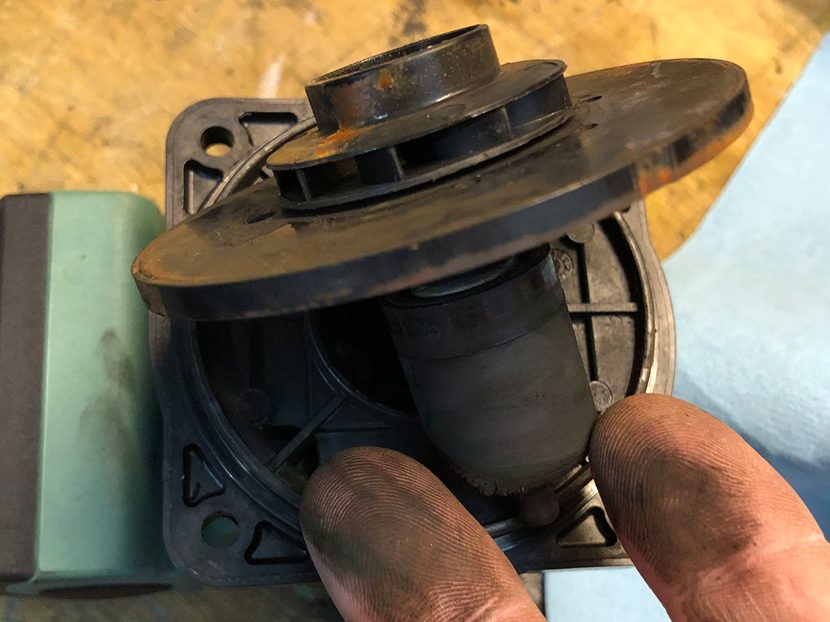No More Dirty Water
New heating technology changed the way we think about H2O in our hydronic systems.

Back in the day, most of us believed getting black water from boilers wasn’t necessarily a bad thing. It usually meant the system wasn’t taking on fresh water because of a leak somewhere. And with cast-iron boilers and PSC circulators, it wasn’t that big of a deal.
In fact, I used to tell my customers that black water was just what I was looking for because it’s what I read in books — books written by folks much smarter than I am. The thinking was that the iron pipe and cast-iron boiler sections rusted as much as the oxygen in the water allowed them to. As long we weren’t adding new water with more oxygen, we’d be all right. And they were right, and I was right. It happens sometimes.
I did it that way in the 1980s, the 1990s and through to the early 2000s. I’d replace a boiler, fill it with fresh water and while purging the air from the water, I’d fill and empty 5-gallon buckets over and over again until the water ran clear, without the tiniest of bubbles left. It worked and it worked well. It was a rare occurrence when water quality caused a problem within the large waterways of the cast-iron boiler sections, the boat anchor three-piece circulators or the wet rotor PSC circs.
And then, things changed. In fact, things changed dramatically.
The importance of water quality
Technology was moving relentlessly forward — it brought new boilers, new circulators, new components and, eventually, the need to reexamine our favorite heat transfer medium, water. Unfortunately, it took us a while to figure out that last part.
I went from installing cast-iron sectional boilers exclusively in 2001 to nothing but modulating condensing boilers at the end of my career, with a mixture in between. I sidestepped most of the issues related to the early problems with mod-cons because I followed the manufacturer’s piping recommendations from jump street. I wish I could say I was as discerning with the new electronically commutated motor pumps.
I lost two ECM circulators early on; I was beginning to think these things weren’t all they were cracked up to be. When a third one failed early, I knew it wasn’t just bad luck. Something was going on and I intended to find out what that something was. I pulled it, replaced it, took the old one back to the shop and dismantled it. It wasn’t pretty; I knew right then that the problem wasn’t the new circulators or the fine folks engineering and manufacturing them.
The problem was that the permanent magnet was exposed to the water and acting as an iron filter. There wasn’t too much conversation about it at the time, but it was clear to me that pump replacements weren’t as simple as they used to be. To this day, some of the pump manufacturers don’t even mention water quality in their installation instructions for their variable-speed, high-efficiency, wet-rotor circulators with ECM, permanent magnet motors. I’m thinking that maybe they should.
Before I pulled it, I knew it was getting power and not moving water. After I pulled it, I knew it wasn’t moving water because the impeller wasn’t moving. It was from an old iron system I flushed and cleaned, then and added a system protectant. It wasn’t enough, though. There was enough black iron oxide on the rotor to stop the day from moving forward. The good news is that I was able to save the pump. I thoroughly cleaned it and gave it a shot of WD40; she spins like a top now.
In this industry, components evolve and with that evolution, we must learn and adjust. Water quality needs to become one of the single most important considerations when designing a modern-day hydronic system. The new systems demand it. If we don’t follow the demands, collectively, we’re going to have problems.
Homeowners and building owners won’t be happy and will lose confidence. Contractors will experience more no-heat calls, inadequate heat calls, and premature failure of boilers and components. Supply houses will be inundated with questionable returns and manufacturers will experience the same. We will all be leaving money on the table and nobody wants to do that.
There are solutions, though. Companies like Adey, Caleffi, Rhomar, Fernox, Sentinel, Hercules and others are there for us with magnetic separators, dirt separators, filters, system cleaners and system protectants. Guys like Bob “Hot Rod” Rohr lead the charge; when Hot Rod says something about the importance of water quality in hydronic systems, you should listen and take notes.
Check the water chemistry
In every modulating condensing boiler installation instruction manual, you will be given parameters for the proper water chemistry of the fill/makeup water. And if you’re not testing, you’re guessing. Test kits are readily available, as well as the ability to send out a water sample to have tested. In the past, I have used Rhomar for both methods. The below values are a sample of what one boiler manufacturer requires:
1. Hardness: Between 5 and 12 grains per gallon.
2. pH: Between 6.5 and 8.5. Levels below 7 are acidic and increase the rate of corrosion; levels above 7 are basic and can cause scale buildup on the heat exchangers. Scaling creates hot spots on the heat exchanger, poor heat transfer and potential premature death of the heat exchanger.
It is also important to note that pH is logarithmic, which means that a pH level of 6 is 10 times more acidic than a pH level of 7. And a pH level of 5 is 10 times more acidic than a 6 and 100 times more acidic than a 7. Little changes in this value make big differences.
3. Total dissolved solids: Less than 350 parts/million and ideally less for proper operation of electronic low-water cut-offs.
4. Chlorine concentration: Less than 150 ppm.
After I lost those three pumps, I changed everything I was doing regarding the quality of the fill/makeup water in the systems I designed and installed. Nothing changes if nothing changes:
• Water test. As mentioned above.
• System integrity. First off, I never took the owner’s word anymore as to whether there were leaks in the system. Once I opened or drained the system, I tested the water. I examined the circulators, the screen on the fill valve and other components. Those checks usually painted a clear picture of the water’s condition and whether I should take a closer look.
If I suspected a leak, I pressure-tested the system or the places most likely to leak and then repaired those leaks as necessary.
• System components. I had been using Y-strainers or filter ball valves. Both are great products, but with the new boilers and circulators, they’re simply not enough. Dirt separators, magnetic separators and black iron oxide sludge filters are now part and parcel for these systems. Without them, your new variable-speed circulator with the ECM, permanent magnet motor will serve that purpose and fail. The magnet in the ECM pumps attracts and collects iron oxide.
These items are no longer options; they are now necessities.
• System flush. All I would do on this step is to flush the system with fill water to purge any contaminants easily flushed before cleaning.
• System cleaning. There are many quality products available for this step. I’ve used Fernox F3, Sentinel X300 and Rhomar 9100. I’d either inject the aerosol or pump in the fluid, depending on which product I chose, while following the manufacturer’s recommendation on the amount to use.
Next, I’d bring the system up to normal operating temperature, which aids in the cleaning process, and run the pump(s) for about four to six hours, sometimes longer. After that, you flush the system for as long as it takes until the water runs clear.
• System protection. The system is now leak-free, cleaned, filled and purged of air. At this point, I would add an approved multimetal corrosion inhibitor such as Fernox F1, Sentinel X100 or Rhomar 922.
Make sure the product you’re using is compatible with the boiler’s heat exchanger and you use the recommended amount. Again, you’ll either be injecting an aerosol through a boiler drain or using a transfer pump to pump it in via a boiler drain.
My own system is still a work in progress and very incomplete at this point, but it will not be connected to an automatic fill water supply. I have it set up to manually feed water through a pressure-reducing valve while using a short, high-strength hose with a female connector on each end.
The reason for this is I don’t want water being added without me know about it. I could have added a water meter, but this will be a simpler solution for less money. The boiler will be protected by a low-water cut-off and the boiler’s integrated temperature controls, offering a degree of protection.
I’m using both an Adey MagnaClean 2XP filter and a Caleffi DirtMag. Why not? I want to see how the two of them work together. The final step I’m taking is to have my water tested before filling the system. If need be, I’ll bring in water from another source to meet the requirements of both the boiler and the circulators.
As an industry, I feel that we are not being vocal enough or not taking the necessary steps to ensure that we’re protecting these state-of-the-art systems. They deserve our attention and a healthy, happy heating medium to keep them operating efficiently without unnecessary, premature failures.
I hope this sheds some additional light on the subject. For a more in-depth view, check out Caleffi’s idronics 18, Water Quality in Hydronics. It’s a wonderful resource that is readily available to everyone.





